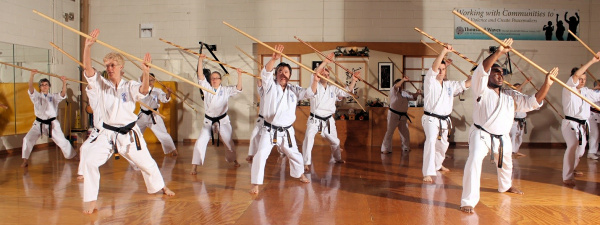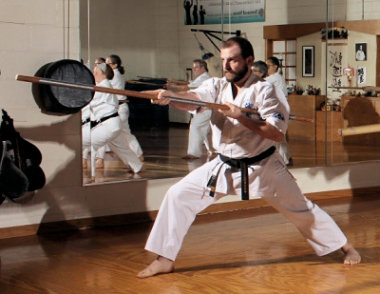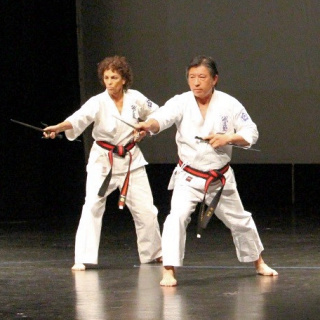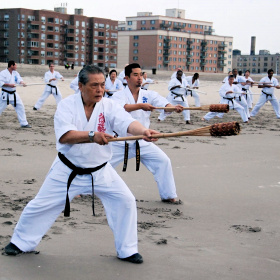2020 February
2018 December August June February
2017 December September June March
2016 November August June March
2015 December October July May February
2014 December October July April February
2013 December October August May February
2012 December September July April February
2011 December September July April February
from the October, 2015 issue of Kiai!
Why Train with Traditional Weapons?
By Christopher Lamitie
Green Belt
I was observing a few Seido black belts training with weapons during open dojo one day when several questions exploded in my head at once. In a world with guns and pepper spray and jump-from-behind strong arm robberies, why train with weapons? Why those weapons? Furthermore, why bother with those weapons, when to walk around with them, is to invite harassment form law enforcement and estrangement from other people in the community? And lastly, why in Seido Karate are weapons taught only to black belts?

Thousand Waves black belts perform with the bo weapon at Kagami Biraki (New Years training) 2015.
I looked to Kaicho Tadashi Nakamura’s book Technique and Spirit for an explanation. The book has an extensive section on martial arts weapons. Kaicho offers these thoughts on the purpose of weapons in Seido Karate. He states:
“Karate students should study the practice of weapons so that in the event of being faced by an armed opponent, they can instinctively understand the types of strikes and thrusts they would have to counter. Also, in a practical self-defense situation, a student with a weapon, such as an umbrella, can extend his or her reach and expand the possibilities for counterattacking. Finally, weapons practice is another discipline that strengthens the mind and the technique.”
– Technique and Spirit, page 135

Sensei Alan with the bo staff.
As we know, Karate has been translated as “empty hand” by Sensei Gichin Funakoshi, however our hands are not empty when we practice with weapons. I asked Sensei Alan about that. He said, “not so much empty ‘hand,’ but being capable of using anything. I think one of the reasons why we don’t teach any weapons work in Seido until black belt is that we have to figure out our own body first, whether it’s your hand or your elbow or shoulder or forearm or your knee or your foot. You have to know how to push those things in which direction and how to be stable on them, because the weapon is an extension of your own body’s mechanics. So if you don’t know how to use an empty hand, you’re not going to really understand how to use a hand that’s carrying a weapon.”
But what purpose does weapons training have for karateka? Sensei Alan told me, “… expanding your understanding of things. In that a lot of people can do a motion just fine with their arm, because they’ve learned it and they’ve practiced it. And you can put something in their hand and tell them to do the same motion and they can’t. Your body somehow thinks you’re doing something different, because now you’re holding ‘this’ (points to his hand with imaginary weapon). And so you have to reprogram your brain and think about how that motion is the same and how one thing you learned applies to something else that you might be learning.”

Kyoshi Marla and Kyoshi Wai wield the sai in the Art With
Heart performance.
Martial Arts weapons are both exotic and archaic. This modern age we live in is filled with weapons far more advanced and lethal than most martial arts weapons. When I brought this up, Sensei Alan corrected me by saying, “They’re not archaic, they’re simple. I think that is the important thing there. I don’t carry a gun with me everywhere … but [a gun is] a more complicated weapon, it’s a complicated mechanism, it’s harder to get, different to train on, it has moving parts. But if somebody walks into an area where I am and they start threatening people, I might have a broom stick or a baseball bat or a kitchen knife – all of those things are still potentially weapons, they’re just simpler than a gun … They are still very practical if you are trying to be non-violent and you’re occasionally pushed to it … If someone does threaten me, I can reach for something close and it’s usable as a club or a baton or a bo or a jo.”
He has a good point, it is far more likely a found weapon will be available than a well balanced staff, and we generally don’t have sai stuck in our belts. So if we feel we need a weapon to defend ourselves, we’ll have to make do with what is around. But wouldn’t that be difficult for us to wield, are there any parallels with found weapons and martial weapons?

Kaicho and Nidaime using tiki torches as improvised
weapons.
“You start out thinking: ‘there’s these 200 different techniques I’m doing and it’s so super difficult to remember them all’ and eventually you get to a point where you’re like ‘oh there’s like three techniques and I just do little variations on them.’ But all the body mechanics are the same because my body works the same way it did yesterday. It works the same for this technique as it did for this other one. And so it’s very easy to transfer that application over to a new weapon.”
So I have learned that, like most things in karate, two, seemingly opposing ideas or objects really are the same thing. One is the Yin, the other is the Yang. A block is a strike and a strike is a block. Then also our empty hands, when filled with weapons, remain empty, because weapons are an extension of our hands. With weapons practice we learn more about distancing and space around us, plus how to use any object available effectively if we must defend ourselves, as well as what those object can do to us, if wielded against us. Weapons practice deepens our understanding of our empty hand techniques, just as our empty hand techniques teach us the mechanics of using weapons.
